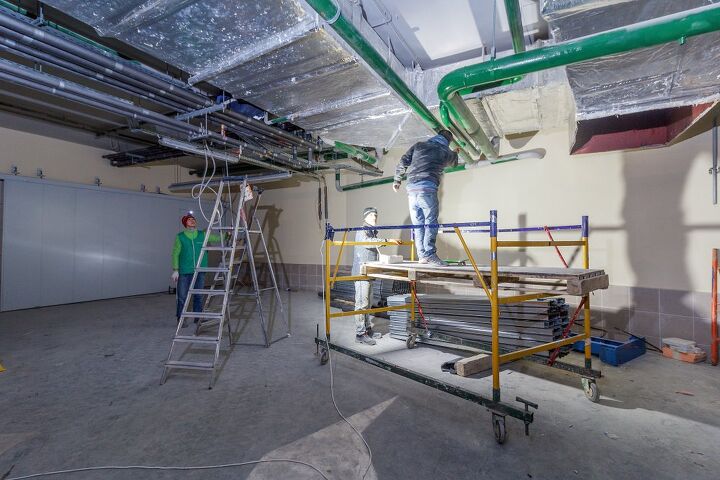How To Insulate Garage Ceiling With A Room Above (Do This!)

Adding a room above a garage is a great way to create additional space. Whether that space is additional storage or another living space is up to you. But when there is no insulation in the garage, it can lead to cold floors in that new space.
The quickest solution is to add insulation to the ceiling of the garage. The simplest way to install is by cutting out a section of the roof and using a blow or spray-in insulation. You can also try replacing the windows and doors in the garage as those can be a source of leaking heat or letting in cold air.
Do You Need Insulation Installers?
Get free, zero-commitment quotes from pro contractors near you.

Why Insulate the Ceiling?
In most cases where it is just the garage, insulation wouldn’t necessarily be important. The only reason it would be is if someone were living in the garage or in an addition right above it. Without a properly insulated ceiling, the flooring can get cold.
If the addition is being used as a livable space, that can create a cold atmosphere that is difficult to warm up. Moreover, that room needs more protection than a room in your home would. Insulating the ceiling can help mitigate cold floors and make the entire space more comfortable to be in.
Step 1: Check for Insulation
Just because you have cold floors in the garage add-on doesn’t automatically mean that there is no insulation. A quick way to check is if your garage ceiling has drywall or plywood. If it does, there’s a good chance that your garage is already insulated.
Do a quick check before getting to business to make sure that the roof is insulated as well. There is a chance that the rest of the garage could be insulated while the roof is not. It all depends on how the garage was installed and when.
Step 2: Cutting a Small Hole
Still unsure about whether or not your garage is insulated? Cut a small piece out of the drywall or remove some of the plywood. Remove and take a quick look inside using a flashlight or other lighting source.
While it isn’t as quick as looking for certain traits, it will provide a clearer answer. The last thing that you want is to purchase all of the supplies only to realize there is insulation in your garage roof. This is a foolproof way to check for certain.
Step 3: Look for an Open Cavity
There is another important thing to look at when checking for insulation. Should you notice an open cavity when removing the plywood, it could be that you need new insulation. Over time, insulation can wear down and lose efficiency and effectiveness.
You may also come to find that the insulation in the ceiling of the garage is adequate but not necessarily sufficient. In that case, you can insulate the flooring of the add-on instead. Checking beforehand is essential for plenty of reasons.
Step 4: Inspect the Insulation
In some cases, the chilling effect that you feel in the add-on may not even be related to the ceiling of the garage. It could be that the stark temperature change is due to something in the bonus room installed over the garage.
If the insulation looks like it should be doing the job, inspect your bonus room. Look for any potential openings or loopholes that could be allowing cold air in. Without taking a deeper look, it can be difficult to diagnose the problem completely.
Step 5: Use a Spray Insulation
Depending on the height of the ceiling and the condition or existence of previous insulation, you can implement a blow or spray-in insulation. The height is important as it can make the process substantially more dangerous.
If the ceiling height is low enough, a do-it-yourself installation is more than possible. When you have a taller garage ceiling, calling a professional to do the job may be the best bet. They can also add blow-in loose insulation or insulation batts to ensure that the job is done safely and properly.
Step 6: Cover the Ceiling
When you are done installing the insulation, make sure that you cover the plywood or drywall again. You will only be doing all that work a disservice by allowing gaps or holes in the ceiling.
Before you install any new materials, make sure that the current insulation (if applicable) is not too thin and that you don’t actually need to add more.
Step 7: Replace Doors and Windows (optional)
When you’re done checking for previous insulation and installing new insulation, you may notice that there is still a chill in your add-on. When that is the case, it may not be the insulation that is at fault at all.
Check the windows and doors in the garage. The windows in the add-on should not be at fault as those are new. Outdated and ineffective garage windows and doors can result in excessive chilling in both the garage and the add-on. Consider replacing them as well.
Tips to Keep a Garage Add-On Warm
Keep in mind that proper insulation, windows, and doors will only go so far. Especially in climates that experience extreme low temperatures, cold can still permeate that garage add-on. The solution isn’t making a big change to the room but simply some minor furnishings.
- Carpeting. Having wall-to-wall carpeting can help to keep a room substantially warmer. It is another layer of insulation between the cold and you, and it won’t retain the cold like wood or laminate might.
- Rugs. If you don’t want to install carpeting, thick rugs can do the trick. Thick rugs can help to reduce the chill in the floor and give you a warm, soft area to stand on instead of the harder flooring.
- Window furnishings. Try implementing heavy drapery or curtains. Window coverings, things like plastic sheets, can help to retain heat in the colder months as well.
- Heaters/fireplaces. The simplest solution is to buy a space heater or an electric fireplace. These will keep any space warm and will often have controls that allow for specific temperature settings.
- Fiberglass batts. This is where having a professional involved can help. Fiberglass batts can be constructed on your own or purchased and then fit into the cavities in the garage ceiling. This allows for better insulation and heat retention without furnishings like rugs or curtains.
What is the Best Material for a Garage Ceiling?
Basic garage ceilings are fine with drywall or plywood. They are both simple, cheap materials that will do the job in a pinch. Drywall in particular is quite easy to nail into the existing beams and can even act as a base should you upgrade to other materials.
Drywall is also a good idea if you are implementing an addition above the garage. You can finish and paint the drywall to give it that complete, clean look.
What Can I Use Instead of Drywall in a Garage?
Should you want to opt for something other than drywall, the best course of action is to use cement board panels. The panels make it quite easy to tile should that be your desire and you can even use stone veneer if you want.
Using the latter, you can give your garage that natural stone wall or exposed brick look that is so popular. With drywall, you would not be able to create that kind of aesthetic. It all comes down to personal preference as there are multiple viable options.
Do You Need Insulation Installers?
Get free, zero-commitment quotes from pro contractors near you.

How Can I Insulate my Garage Cheaply?
Budget always plays a role in the work that we do. Even if you have already put the cost in to installing an additional room above your garage, the last thing that you want is additional costs. So, it only makes sense to find a cheap garage insulation.
Perhaps the cheapest and easiest insulation is fiberglass roll. This is the best option if the garage’s interior walls have not been built, however. Just unroll the insulation in between the wall studs, ensuring that the vapor barrier is facing towards the inside of the garage. For walls that have been built, a spray insulation is probably the best way to go.

Ryan Womeldorf has more than a decade of experience writing. He loves to blog about construction, plumbing, and other home topics. Ryan also loves hockey and a lifelong Buffalo sports fan.
More by Ryan Womeldorf










![Finishing Basement Without Permit [Is It Really Illegal?]](https://cdn-fastly.upgradedhome.com/media/2023/07/31/9070078/finishing-basement-without-permit-is-it-really-illegal.jpg?size=350x220)
![How Much Weight Can a 4×4 Support Horizontally? [It Depends!]](https://cdn-fastly.upgradedhome.com/media/2023/07/31/9070333/how-much-weight-can-a-44-support-horizontally-it-depends.jpg?size=350x220)

![10 Best Electric Pressure Washers – [2022 Reviews & Guide]](https://cdn-fastly.upgradedhome.com/media/2023/07/31/9070600/10-best-electric-pressure-washers-2022-reviews-guide.jpg?size=350x220)













